Since RIPE was formed in 1989, its many challenges and changes have had one thing in common - they've all been discussed on community mailing lists. In this article, we analyse participation in the mailing lists over the years, where the history of RIPE was written.
Over the course of more than 30 years, we've had many mailing lists, with quite a few surviving into 2024. Some were replaced by or split into other mailing lists and others were discontinued, but all are archived on our website.
These archives tell us many stories about the history of our community, and also how our community communicates. How much traffic is going on on the mailing lists? Are mailing lists losing popularity as new mediums emerge? Is there only a certain bunch of people keeping them alive? Are we reaching as many people as we think when we send an email?
These questions branch beyond assessing the popularity of the mailing lists and reach out to important discussions about participation and representation of everyone in our community. We looked into the data from 31 of the most prominent and popular mailing lists to get some answers to these questions.
There are quite a few other active mailing lists that we could have included, but for the purpose of this analysis we disregarded those with little to no traffic since they were started. We included all working groups regardless of traffic due to their importance for the community.
Overview
The below graph accounts for over 30 years worth of emails from 31 mailing lists piling up since 1992, grouped by year. The drop in 2024 is not really a drop as the year is not over yet and this graph includes mails until May.
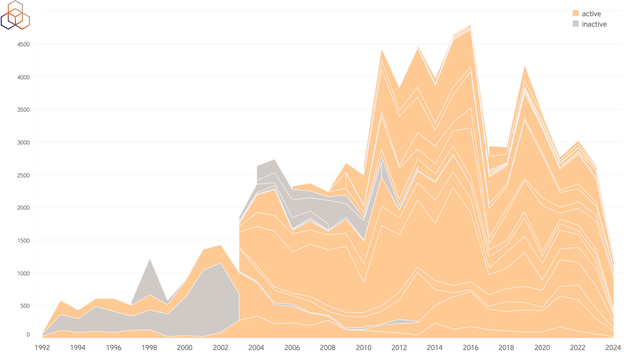
It all started with DNS Working Group’s mailing list in 1992. Over time, new and more mailing lists made room for more discussions - and more people! The jump in 2003 is a good example of that, when the number of emails per year increased as new mailing lists started. Then we see another jump in 2011, this time mostly due to increasing traffic in existing mailing lists.
The yearly numbers of emails sent give us a good overview and show us the major changes in mailing list traffic since 1992. It doesn’t tell us if the traffic is regular. Below is the same graph with two others next to it where the mails are separated into quarters and months. From left to right, yearly to monthly, the graphs get spikier. This is a sign of irregular traffic. There are months that go quiet and months that make some of you annoyed with the heavy frequency of the emails you get.
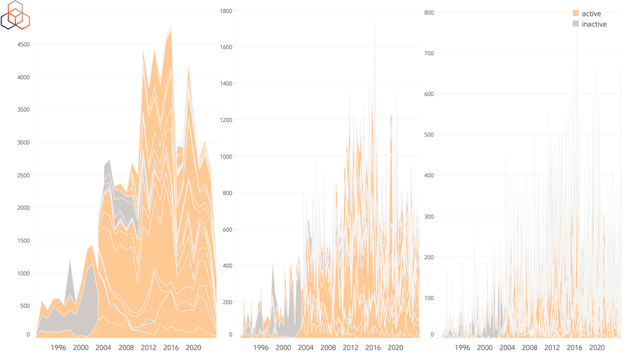
Timeline
Let’s separate the mailing lists and have a look at the timeline to observe the changing frequencies. Below is a dashboard of the mailing lists sorted chronologically, where all the emails are marked on the horizontal timeline. Each transparent stroke corresponds to a single email, hence the brighter parts show when a mailing list had a lot of traffic. Some mailing lists are lit by more emails than others and some have more regular traffic than others.
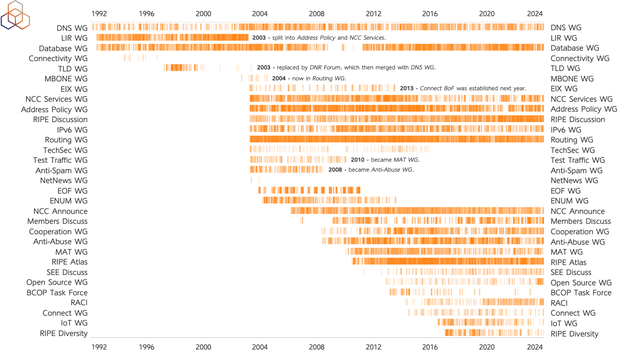
The RIPE community’s first mailing lists belonged to the DNS, LIR and RIPE Database Working Groups, all starting in 1992. 2003 is a big year in RIPE mailing list history. The TLD WG was replaced by DNR Forum, which later was merged with the DNS WG. The LIR WG was split into the Address Policy and RIPE NCC Services Working Groups. Along with those two, eight other mailing lists started: EIX WG, RIPE Discussion, IPv6 WG, Routing WG, TechSec WG, Test Traffic WG, Anti-Spam WG and NetNews WG. Four of these are now inactive while the Anti-Spam WG re-chartered to become the Anti-Abuse WG (and just last week re-re-chartered to become the RIPE Security WG).
Two mailing lists more interesting to the membership, RIPE NCC Announce and Members Discuss, were introduced in 2006 and 2007, respectively. A mailing list for RIPE Atlas enthusiasts was formed in 2010 and became one of the hottest mailing lists. More mailing lists followed after that, but none with substantial traffic in the last decade.
Hot lists
Comparing the amount of transparent strokes might hurt our eyes. Instead, we can compare the average number of emails per month sent to each mailing list in the graph below. Address Policy, Anti-Abuse, RIPE Atlas, Members Discuss and Database are the most popular active mailing lists. It is especially impressive that Database makes it in the top 5, having been around since 1992.
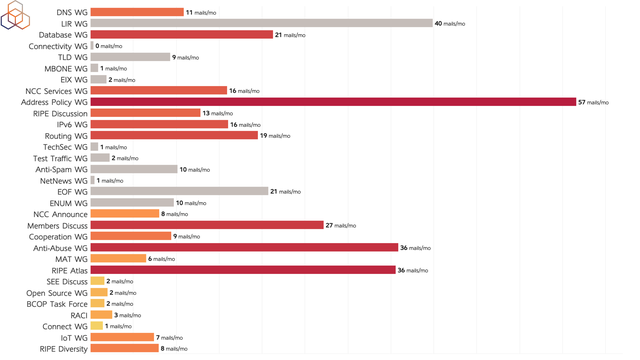
Address Policy WG (one of the two offshoots of the popular LIR WG) is the most popular mailing list by far, which shouldn’t be much of a surprise as it is the working group that develops policies relating to the management and registration of Internet addresses and routing identifiers in our service region. Below is a graph showing the quarterly number of emails sent (orange) and number of unique accounts that sent emails (blue) each quarter to the Address Policy mailing list. There are two big peaks and a decline in traffic after 2016, which coincides with the end of the IPv4 runout and transfer-related discussions, leaving fewer topics for the group to discuss. But policy discussions still take place, with the current proposal to revise the IPv6 PI policy having seen 12 people contribute 30 mails to the Address Policy list (at the time of writing).
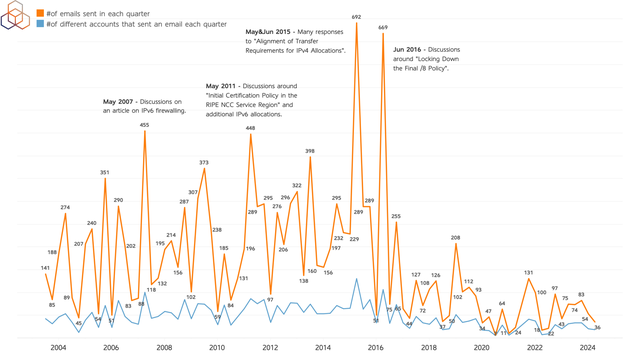
A decline in Address Policy mails is partially responsible for the decrease in the total traffic across all mailing lists after 2016. It suggests that one factor behind decreasing traffic over recent years is simply that there is less to talk about in terms of address policy-related topics. This, and the fact that traffic is irregular over time, shows us that the ups and downs in email traffic are caused mostly by events or topics worthy of sending an email. The decrease in the total traffic is therefore less about the community’s reluctance to engage in conversations on the mailing lists.
Members Discuss is the most widely used mailing list. Over 1,000 unique accounts have sent an email to this list. Around 40 different accounts send emails each quarter. Charging Scheme discussions managed to bring over 100 different accounts to share their opinions on the hottest recorded quarters. As can be seen in the graph below, the peaks in Members Discuss are mostly caused by members talking about topics around money - charging scheme and the RIPE NCC’s budget.
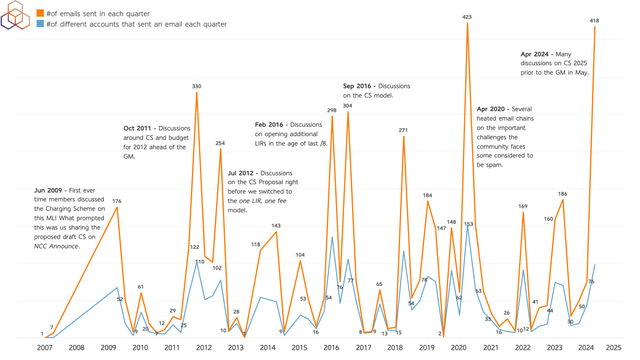
These peaks indicate that many people are involved in the discussions and are motivated to join when there is a topic of importance to them. The same peaks cause some people to reconsider their subscription to the mailing list. Many of you unsubscribed during the period leading up to the GM in May 2024. It could be reason enough for all of us to reconsider how we communicate on mailing lists.
Participation
We have looked at the traffic in the mailing lists, but how many people are actually causing this traffic? Below is the yearly number of emails again with the number of unique accounts that sent an email that year in blue. As the number of emails sent increases, so does the number of different people sending emails. In other words, email traffic increases because more people send emails. When there are new mailing lists created and hot topics discussed, they bring more people!
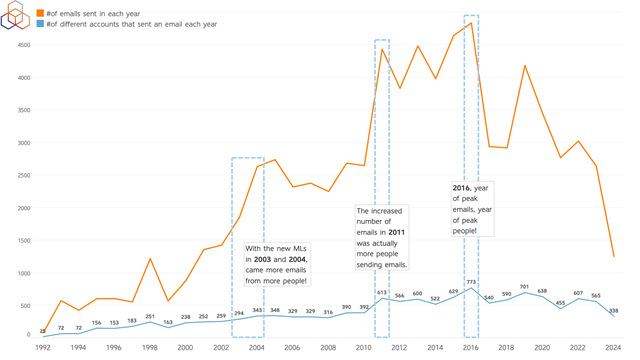
After the increase in the mailing traffic in the previous decades and the decrease after 2016, we can now say that around 600 people join the conversations in 20 mailing lists every year. That’s a RIPE Meeting full of people!
A RIPE Meeting brings together many people who have been in this community for a very long time, but we are always working to bring new people into the community to make sure we are getting new perspectives and ensuring it remains vibrant. Similarly, it is worth asking if the people joining in the discussions on the mailing lists are the same people who have been contributing since the 1990s or the early 2000s.
In the left of the figures below, there is a bubble for each email address that has ever sent an email to any of the mailing lists. The more emails they have sent over the years, the bigger their bubble. The users that sent their first emails earlier are located more to the centre and painted more yellow. The users that joined in the discussion later are located further from the centre and coloured greener. In the bubbles that are big enough, the year the user sent their first ever email to one of these mailing lists can also be seen.
Bigger bubbles tend to be yellower and more central! But we shouldn't leap to any hasty conclusions. Older members might have sent more emails, but that might just be because they've been doing this the longest. The more interesting question to ask is... are they still more vocal than the newer contributors to discussions?
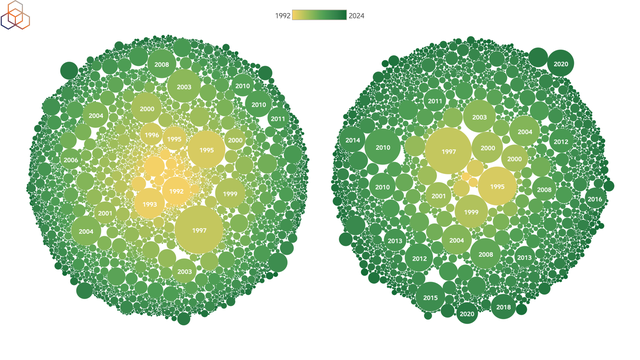
In the modified version of the same figure on the right, only the emails sent after 2014, in roughly the last decade, are counted. The gap between the biggest and smallest bubbles shrank. However, the biggest bubbles are still shining yellower around the centre!
Clearly, the older participants are still contributing more to the conversations on the mailing lists. And longevity as a determinant of participation should probably not be surprising or considered a bad thing. After all, these people have a lot of experience in their professions and with the workings of the community. And they are more likely to know other regular participants on mailing lists or from RIPE Meetings and similar networking events, likely making the barriers to participation much smaller for them. But we do know that eventually the regular participants will retire and leave the community, so attracting new participants is important for stability as much as it is needed to grow the community.
The reasons people don’t join the mailing lists is something we should always be considering and looking to address. Is it intimidating to join discussions? Do younger generations prefer different means of discussion? Are there ways to link the discussions happening on social media and in other channels to those taking place on the mailing lists? All these topics arise every now and then and could potentially make for a worthwhile mailing list discussion!
Inclusivity towards newer people is one thing, but a big group of people that the mailing lists are perhaps unintentionally excluding are non-English speakers. The language of the mailing lists is English and it is likely difficult to participate for non-English speakers, or even people with low English proficiency. This creates an uneven problem as English proficiency varies across our service region of 76 countries spread over Europe, the Middle East and Central Asia. As we think of how useful mailing lists have been until now and their future, we have to recognise that this medium in RIPE is mostly limited to English speakers and this is something that we need to consider. Non-English-speakers are affected just as much by the outcomes of policy discussions - so how do we involve these people in the dialogues around important topics in our community?
A tool for consensus
Why analyse the number of mailing list participants, their longevity, or their proficiency in English? In short, it all comes down to questions about representation - questions that resurface when we see lulls in activity and communication, such as the drop in policy proposals over the COVID period and the overall decline in email traffic after 2016.
One might view the total number of emails/mailing list participants similar to votes/potential voters in a democratic election, with general agreement that more is always better. But while increasing participation is of course something we work to support, maybe we should be careful about internalising this view too much. After all, as a certain IETF document famously states, "We reject: kings, presidents and voting." – the Internet runs on consensus (and sometimes humming).
Another way to think about this could be in terms of democratic potential rather than voter turnout. Numbers at the ballot are only one measure of a democratic society, and perhaps not the best one. More important is a society's potential to act when needed. From this perspective, perhaps it's better to look at analysis of the mailing lists as a way of testing the hypothesis: "The RIPE community/RIPE NCC membership will act when it sees a need to do so."
This seems relevant when we consider that, for now at least, many of the "big issues" (IPv4 transfers, multiple LIRs, IPv6 policies) appear to have largely been solved. That being the case, should we expect to see a similar level of engagement today as in 2016 when these issues were still being hashed out? What seems more important than maintaining high levels of participation is whether people will engage again to the same extent in future should the need arise.
Conclusion
We could dive still deeper into the mailing list archives and questions about the democratic potential of our community. For now though, it's worth stating that the mailing lists have been an essential part of the work of the RIPE community for more than 30 years and are still being widely used. All the policies that determine how the Internet works in our region, and all the decisions that have shaped how this community operates, have in one way or another been discussed on these lists. More than that, the archive of every discussion is available for all to see, providing transparency and incredible insight into how we got where we are today.
So what is the future of the mailing lists? Looking at the data we have, there is no sign that email, with its dependability and low threshold for allowing participation, is fading as a medium for important discussions. However, we can also see that there are several challenges involved in bringing newer people into email list discussions. Perhaps the main challenge should not be seen as "How do we get more people to use email?", although that is something we would love to see, but rather how do we continue to involve as many people and perspectives as possible given the vast array of channels available and the varied communication preferences of people in our community? Answering that question feels important if we are to ensure we have another 30 years of valuable discussions that shape the future of the Internet in our region and industry.





Comments 0
The comments section is closed for articles published more than a year ago. If you'd like to inform us of any issues, please contact us.